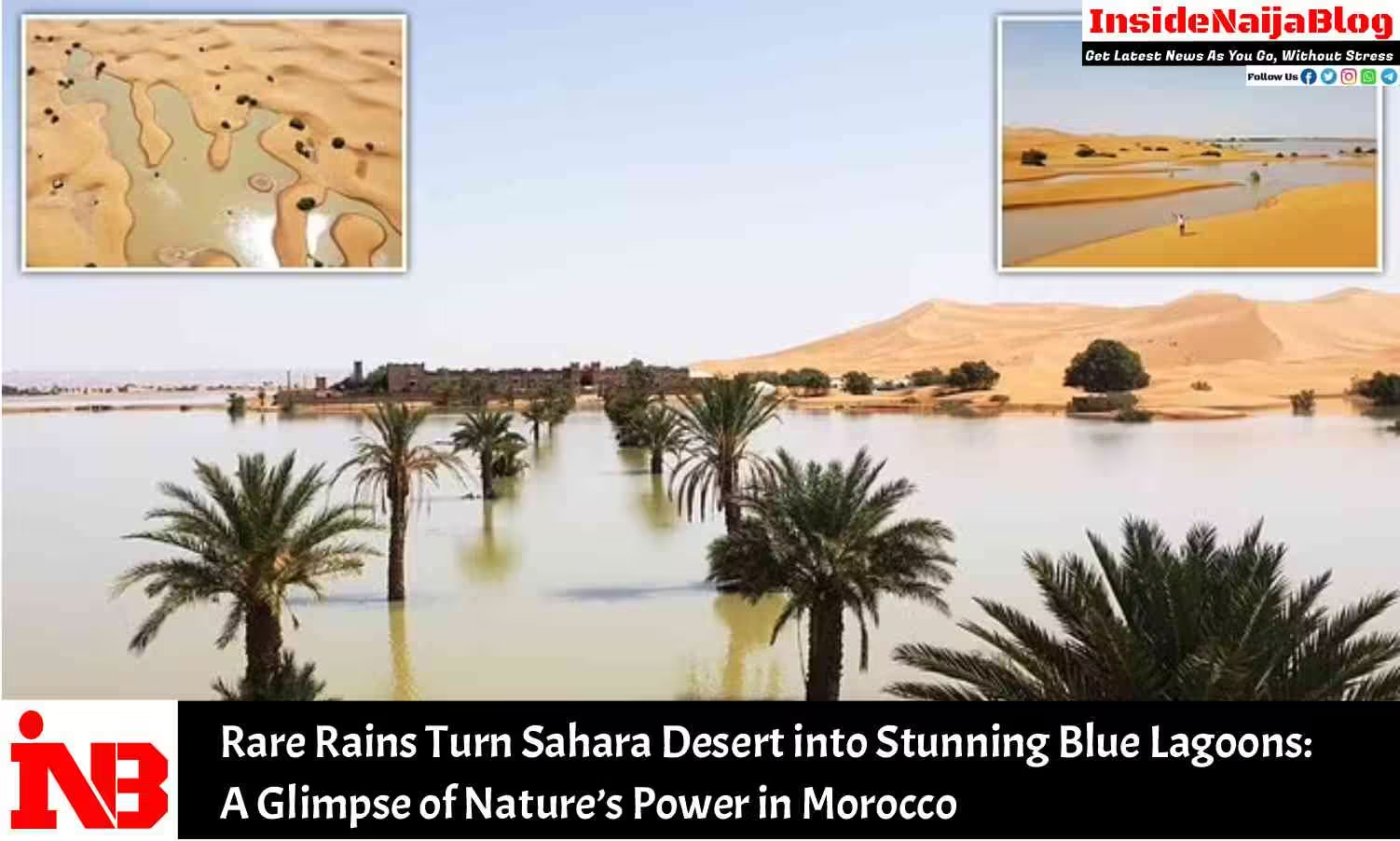When people think of the Sahara Desert, they imagine vast, endless stretches of golden sand dunes, unrelenting sun, and an environment so harsh that it seems life itself struggles to survive. The Sahara is not only the largest hot desert in the world, but also one of the driest, with regions that can go years without a single drop of rain. However, in a shocking and rare turn of events, the unthinkable happened: torrential rain fell upon the desert, transforming the arid landscape into an extraordinary vision of blue lagoons and water-filled basins. This breathtaking scene unfolded in southeastern Morocco, a region that had not seen significant rainfall in decades.
In early September, the skies over Morocco darkened, and what followed was nothing short of miraculous. Within just two days, parts of southeastern Morocco experienced more rain than they usually receive in an entire year. Areas like the village of Tagounite, located approximately 450 kilometers south of the capital Rabat, were among the hardest hit. Over 100 millimeters of rain poured down in a 24-hour period, flooding the village and turning dry riverbeds into flowing streams. It was a spectacle rarely seen in the region, a once-in-a-lifetime event that left both locals and meteorologists in awe.
This region, part of the wider Sahara Desert, is known for its blistering temperatures and its lack of rainfall. Yet the storm brought torrential rains that swept across vast expanses of desert, even filling up dry lake beds that hadn’t held water for generations. Perhaps the most remarkable transformation occurred at Lake Iriqui, a lake bed that had remained completely dry for over 50 years. To the astonishment of locals, the lakebed was filled with water once again, creating an oasis-like scene in the middle of one of the driest regions on Earth. For the first time in decades, Lake Iriqui resembled a real lake, with water gleaming under the desert sun, surrounded by towering sand dunes and palm trees.
A Storm Like No Other: The Science Behind the Rains
The rain event was so unusual that many residents could hardly believe it when they saw water pooling around their homes and palm trees. According to Morocco’s General Directorate of Meteorology, it had been anywhere from 30 to 50 years since such intense rainfall had been recorded in such a short period. Houssine Youabeb, a representative of the meteorological department, remarked on the historic nature of the storm, noting that the rainfall was more than just a rare occurrence—it was unprecedented.
This extreme rainfall was the result of an extratropical storm, a weather system that forms outside the tropical regions and can produce heavy rain, high winds, and, in some cases, significant flooding. These storms are usually less common in North Africa, but climate experts have suggested that global warming could be contributing to changes in atmospheric patterns, making such storms more frequent. The impact of these weather shifts may bring both benefits and challenges to regions like Morocco, where rainfall is desperately needed but where the infrastructure is often ill-equipped to handle sudden deluges.
While the heavy rainfall provided much-needed water for the parched land, it also came at a cost. Southeastern Morocco, especially areas like Tata, received far more rainfall than usual, leading to flash floods and significant damage to both homes and crops. These flash floods, which can occur when the ground is unable to absorb water quickly enough, wreaked havoc on the region. Farmers, whose livelihoods depend on the success of their crops, were some of the hardest hit. Many saw their fields completely submerged in water, with crops washed away or damaged beyond recovery.
A Nation in Drought: Relief and Replenishment
For a country like Morocco, which has been suffering from a prolonged drought for six consecutive years, the downpour was both a blessing and a challenge. In many areas, water shortages had reached critical levels, with reservoirs running dangerously low and underground aquifers slowly drying up. The rains, however destructive in some ways, offered the potential for a much-needed respite from the ongoing water crisis. Local officials reported that the sudden influx of water helped replenish groundwater reserves and refill critical reservoirs that supply drinking water to rural and urban communities alike.
For areas like Tata and Tagounite, where agriculture plays a vital role in the local economy, the rain offered a brief window of hope. The replenished water levels could help farmers plant new crops, and, with proper planning, the rainwater could be harvested and used to support agriculture in the months to come. However, the damage caused by the flooding also meant that many farmers faced an uncertain future, with lost crops and financial losses looming large. The Moroccan government responded quickly, releasing emergency aid to help those affected by the flooding. This included assistance for farmers, whose crops had been devastated, and support for rebuilding homes and infrastructure that had been damaged by the sudden downpour.
The Beauty and Power of Nature: A Changing Landscape
While the floodwaters brought devastation in some areas, they also created scenes of extraordinary beauty in others. The image of water flowing through the desert sands, reflecting the clear blue sky and framed by towering palm trees and golden dunes, was a stark contrast to the usual barren, sun-scorched landscape of the Sahara. The sight of the re-flooded Lake Iriqui was particularly striking, a reminder of how quickly the forces of nature can transform even the most inhospitable environments.
For many, these rare blue lagoons in the heart of the desert were a symbol of hope, a reminder that even in the driest, most desolate places, life can find a way. The water brought a temporary burst of life to the desert, with plants blooming and animals gathering around the water’s edge. This brief moment of beauty, however, came with the stark realization that such events are becoming increasingly rare in a world that is changing fast.
Climate Change and the Future of North Africa
As the world continues to grapple with the effects of climate change, regions like North Africa are particularly vulnerable to extreme weather events. Droughts have become more frequent and more severe, while storms like the one that drenched the Moroccan desert are expected to become more common. For countries like Morocco, this presents a complex challenge: while the rain is desperately needed to combat water shortages, the country’s infrastructure is often ill-prepared to handle sudden floods and extreme weather events.
Experts warn that unless steps are taken to better manage water resources and prepare for future storms, events like this one could lead to more destruction and displacement in the years to come. The Moroccan government is already working on long-term strategies to improve water management, including the construction of new reservoirs and the implementation of better irrigation systems for farmers. However, the challenge remains: how to balance the need for water with the risk of extreme weather, all in the face of a changing climate.
In the end, the rare rains that turned the Sahara into a temporary paradise of blue lagoons serve as a reminder of both the beauty and the power of nature. While they offered a momentary glimpse of relief and hope, they also highlighted the pressing challenges facing the region. As the people of Morocco continue to adapt to the forces of nature, the world watches, knowing that this fragile balance between drought and flood will define the future of this unique and awe-inspiring landscapes




